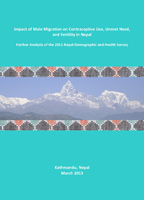- PUBLICATIONS
- JOURNAL ARTICLES
- ACCESS PUBLICATIONS
Publications Summary
- Document Type
- Further Analysis
- Publication Topic(s)
- Fertility and Fertility Preferences
- Country(s)
- Nepal
- Survey
- Nepal DHS, 2011
- Language
- English
- Recommended Citation
- Khanal Mukti Nath, Dirga Raj Shrestha, Prakesh Dev Pant, and Suresh Mehata 2013. Impact of Male Migration on Contraceptive Use, Unmet Need and Fertility in Nepal: Further analysis of the 2011 Nepal Demographic and Health Survey. DHS Further Analysis Reports No. 74. Calverton, Maryland, USA: Nepal Ministry of Health and Population, New ERA, and ICF International.
- Download Citation
- RIS format / Text format / Endnote format
- Publication Date
- March 2013
- Publication ID
- FA74
Download
 Impact of Male Migration on Contraceptive Use, Unmet Need and Fertility in Nepal (PDF, 1249K)
Impact of Male Migration on Contraceptive Use, Unmet Need and Fertility in Nepal (PDF, 1249K)
Download this publication
There is no printed copy available to order.
